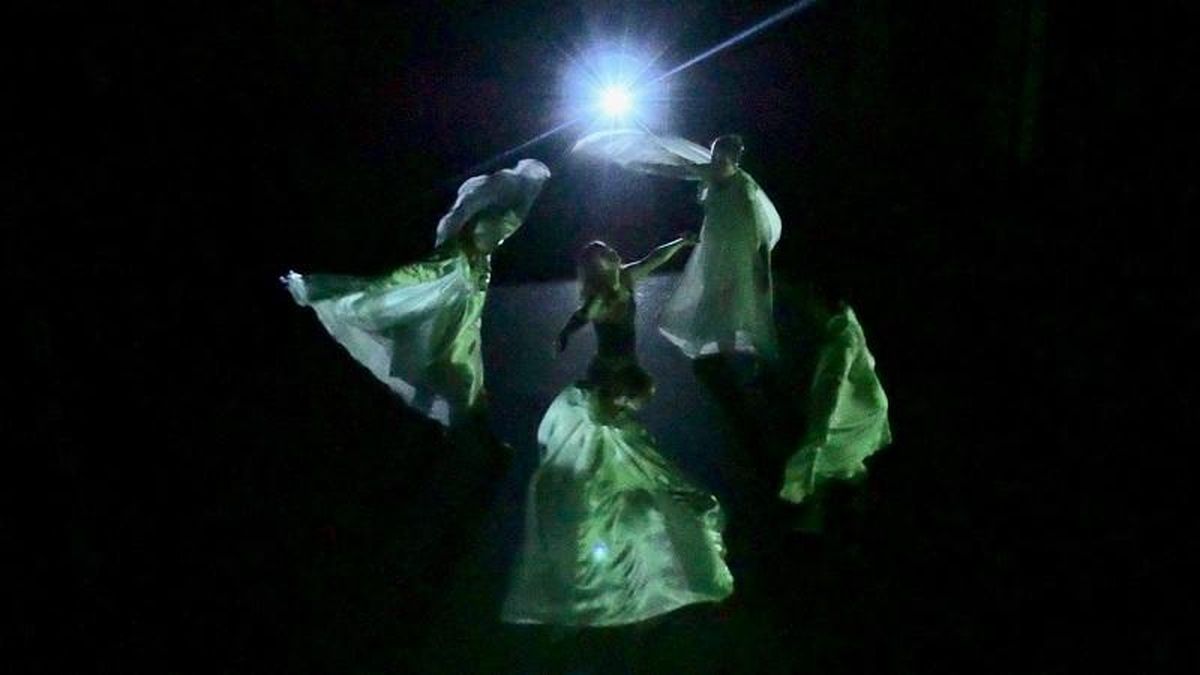Summer residency program at Spokane’s Laboratory results in dance/multimedia projects
“Fighting With Air,” a film by Rossina Rossio, explores the stages of a performance, from interviewing dancers to settling on the right quality of movement and best makeup and costuming, to the final stage of putting everything together with the right dancer. It’s being shown Aug. 25 as part of an artist residency program through Laboratory.
Interactive artists from all over the world traveled to Spokane’s Laboratory this summer to collaborate with some of the city’s most accomplished movers and shakers. And by “movers and shakers” we mean local dancers.
Five new media artists and filmmakers from France, South Korea, Ireland and Colombia have been working with more than a dozen local dancers to create four very different interactive and technology-driven experiences for Spokane audiences. Three months of intense preparation, funded through a grant by Spokane Arts’ SAGA program, has culminated in four cross-disciplinary collaborations ready to be performed or shown in August.
The four dance performances/installations produced by the international Laboratory resident artists are:
French duo Dorianne Wotton and Xavier Exomene, along with local dancer and artist Anna Czoski and dancer Matt Doval, presented a dance performance and installation called “Phygitalide” at 9 p.m. Thursday at Saranac Art Projects, 25 W. Main Ave. Exomene built computerized sensing units to monitor the movements of two tango dancers. As they glided and spun, the dancing couple’s actions caused the computer to create and project digital images on the dance floor.
Exomene and Wotton seek to present technology as a positive force in life. “Technology is presented as evil, that it destroys the social aspects of life,” Exomene said. “But here in our piece, the machine and the man are collaborating to create beautiful art.”
“The work is called ‘Phygitalide,’ meaning part physical and part digital,” Exomene said. “It’s like a worm in a chrysalis transforming into a butterfly; the merging of the physical and digital will give birth to a new form.”
The second set of artists will explore the darker side of modern technologies in a performance called “nevertheless” by Korean new media artist Sangjun Yoo. In collaboration with choreographer Karla Parbon, who heads Whitworth University’s dance department, and with dancers Brooke Grisson and Melanie S. Williams, also from Whitworth, Yoo will combine Parbon’s modern choreography and improvisation with real-time interfaces, smartphones, and data visualizations.
The resulting performance will examine the existential crisis of the millennial generation, portrayed through the lens of smartphones and selfies. The dancers will visually represent what people experience when dealing with technologies’ distractions. For example, at one point, “we do improvisational movement to make almost a mockery of the selfie way of being, and how to get the perfect pose,” Parbon said.
Yoo, a doctoral candidate at the University of Washington’s Center for Digital Arts and Experimental Media, holds two BFA degrees in design and technology and spent four years working at global design firms, including MTV.
“My work engages the space between what is seen and what is processed through the mind,” Yoo said. “There is a learning curve for everyone on how to communicate with people from different backgrounds, and to voice what you are thinking.”
There are no rendered images in the show; all modes of creating visual art for the piece will produce new imaging on the spot. Yoo will even pull in subtitles from live radio streaming that viewers’ brains will process along with the imaging in real time.
“Nevertheless” will be performed at 8 p.m. Aug. 24 at the new site of CMTV14, Spokane’s nonprofit community access television station at 104 W. Third Ave. on the corner of Third and Browne.
The last two dance/digital arts performances will be featured in two separate gallery rooms at Saranac Art Projects at 8 p.m. Aug. 25. These two pieces are filmed performances of dancers that are projected onto the Saranac’s walls.
In “Immersion,” by Irish filmmaker Deirdre O’Toole, the artist collaborated with dancers from Gonzaga University’s Theater and Dance department to create a 360-degree immersive video exploring a near-drowning experience.
O’Toole credits Gonzaga University’s dance program director Suzanne Ostersmith with inspiring her with ways to show water without actually using water. (Filming underwater was not in the budget.)
“Before even coming to Spokane I had seen online the work that Suzanne Ostersmith had been doing dancing with silk fabric, and the movement of it really looked to me like water, the sea and the waves of the silk,” O’Toole said. “What she did with the dancers was just so unbelievable to me.”
Four current and former Gonzaga alumni, including Ostersmith, dance the part of water in the film. An actor portrays an off-camera narrator, whose voice relates her true near-drowning experience as a five-year-old.
“A lot of the film is about how that experience changed her perception of death,” O’Toole said.
The final piece, also at the Saranac on Aug. 25, is a film by Colombian native Rossina Rossio exploring not only the struggle of creating a dance video, but also the struggle we all carry within ourselves, appropriately called “Fighting with Air.” Rossio collaborated with dancers from Vytal Movement Dance Company, as well as local dancer Mackenzie Fagras.
Rossio, who is also a painter, is the only one of the five international interactive artists who dances in her own Laboratory piece. She said it was her greatest challenge. As a dancer, the performance was the easier part; it was the logistical problem of filming herself that was difficult.
“That was a crazy day at the CMT station – I was jumping back and forth from behind the camera,” Rossio said. “But fortunately the people at the station helped me so much.”
“It’s very different to perform in front of a camera instead of on stage,” Rossio said. “With just a camera and no audience feedback, I feel very naked there. But the reward is you can play with the footage and do a lot of interesting stuff with it.”
Rossio’s film explores the stages of a performance, from interviewing dancers to settling on the right quality of movement and best makeup and costuming, to the final stage of putting everything together with the right dancer.
“There was a struggle actually building the video, finding the way with my tools and the dancers I was able to collaborate with,” Rossio added. “These inner and outer struggles are what we all go through in life.”
“I am interested in this idea that we are all fighting something invisible inside of us that only ourselves know,” Rossio said. “If we accept that struggle, we might see it as something beautiful instead of threatening or ugly.”

